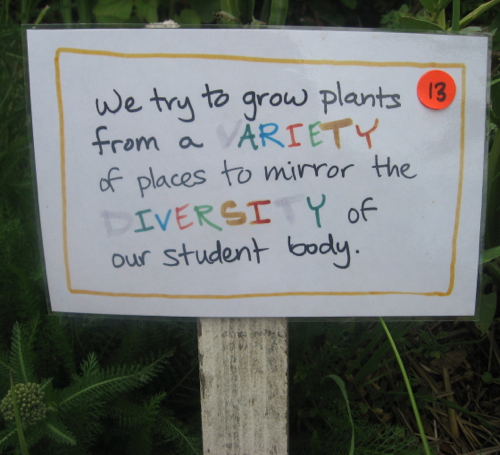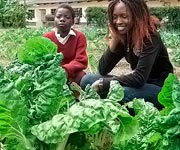Food Studies features the voices of volunteer student bloggers from a variety of different food- and agriculture-related programs at universities around the world. You can explore the full series here.
 A sign at the Edible Schoolyard“This is some slavery shit.”
A sign at the Edible Schoolyard“This is some slavery shit.”
It was a sunny August morning, and we were hoeing, loosening up the dirt in an empty bed so that we could plant lettuce seedlings. I was volunteering in a summer school garden class at a high school in St. Paul, and we were nearing the end of the session.
I was helping one student wrestle with some weeds, when I heard another student say it. “This is some slavery shit.” I looked up. The student who said it — an African-American male around 18 years old — did not seem particularly distressed or angry; he was smiling and his voice had a joking tone. Still, his words were serious. A group of his friends nodded and laughed.
Before I could do anything, one of the nearby garden teachers jumped in, engaging the student in a one-on-one conversation. Later, she told me that she thought the conversation had gone fine, but she hadn’t been sure what to say, and she wondered if there was a better way to handle that situation.
Now it’s almost winter in Minnesota, and the garden class is no longer in session. But I still think about this comment. As the rule of teaching goes, if one student said it, then at least a couple others were thinking it. And even though this student seemed to be purposefully exaggerating, he did not just say he was tired, or that he hated farming; rather, he compared the activity to a system of forced labor.
Last year, The Atlantic published a particularly incendiary — and subsequently much-discussed — article criticizing the school garden movement. Among other criticisms, the writer, Caitlin Flanagan, asserted that school gardens perpetuated an oppression of minority students with histories of migrant farm labor and slavery in their backgrounds.
This article opens an almost infinite can of worms, and I disagree with much of it, but I don’t think its concerns should be dismissed entirely. For one thing, it shows us that, for some people, these associations exist. And the school garden movement should be able to address them.
Farming has the potential to bring up deep-seated negative associations for students of all races. But for students of color, those associations might run especially deep. The simple act of getting the students on the land can often replace negative connotations with positive ones. But sometimes we have to address the issue head-on. And, if that’s the case, then what do we say?
When I was touring the Edible Schoolyard in Berkeley this past summer, I noticed a small sign nestled among the vegetables. “We try to grow plants from a variety of places to mirror the diversity of our student body,” it said. It was hand-drawn by a student, and the words “variety” and “diversity” were emphasized with letters drawn in a rainbow of colored markers. The sign made me smile. It was a small gesture, but it managed to gracefully acknowledge a significant concern, and, in doing so, open the garden up to a much larger conversation.
Increasingly, I wonder if it might be beneficial for everyone — students, teachers, and the wider public — to bring this conversation up right away. In school, that might mean starting a garden class with a discussion about farming. Then, instead of responding to the few students bold enough to voice their thoughts as they come up, the teacher would be the one to initiate the discussion, inviting students to process their thoughts and emotions in a structured, constructive way from the very beginning of the class. One approach a teacher might make is to ask the students to make a list of both the positive and negative associations they have with farming, and then lead a group discussion of those lists. Another idea is that students could write a journal entry after the first day, about what they expected farming to be like, and what they actually found.
These are just a few ideas, stemming from my own experience. I believe in the school garden movement, and I want to help strengthen it by addressing this difficult question, but I need help. If you have thoughts or suggestions, I would love to hear them in the comments below.



